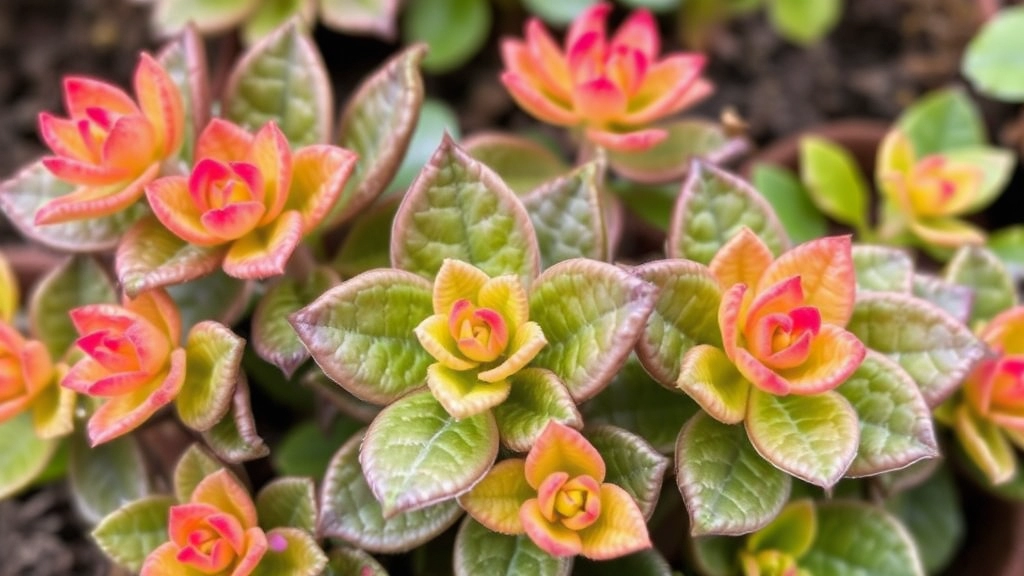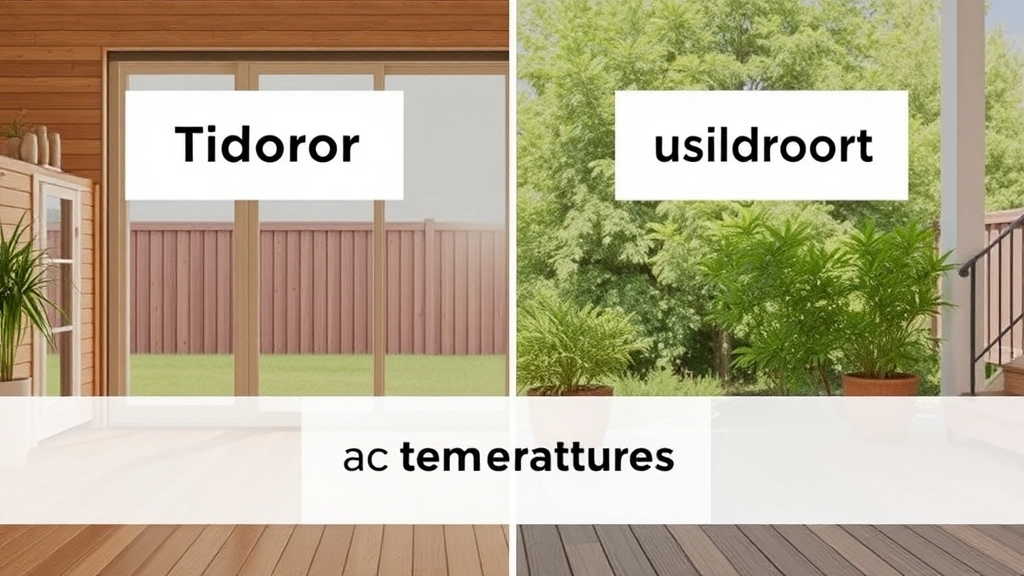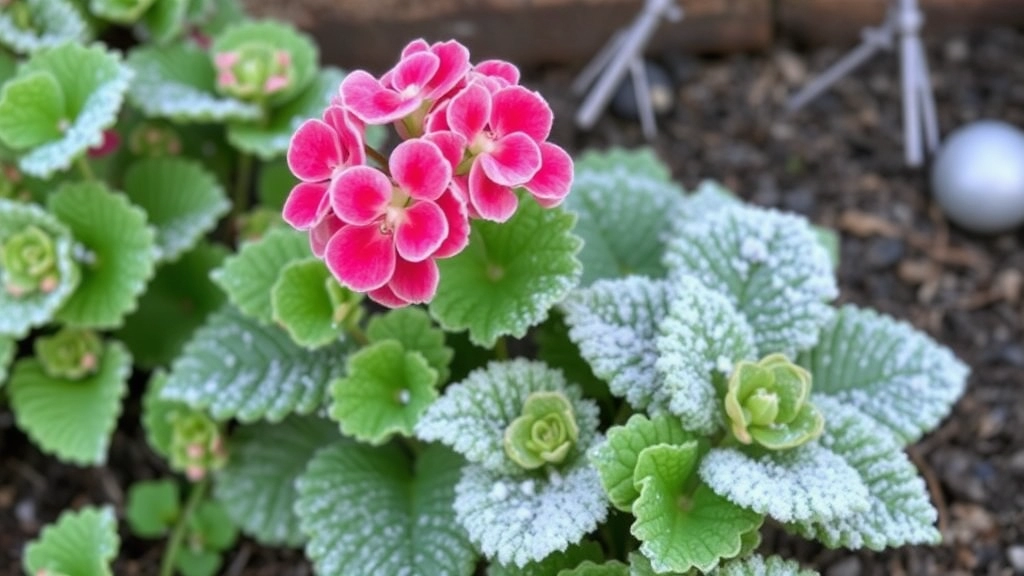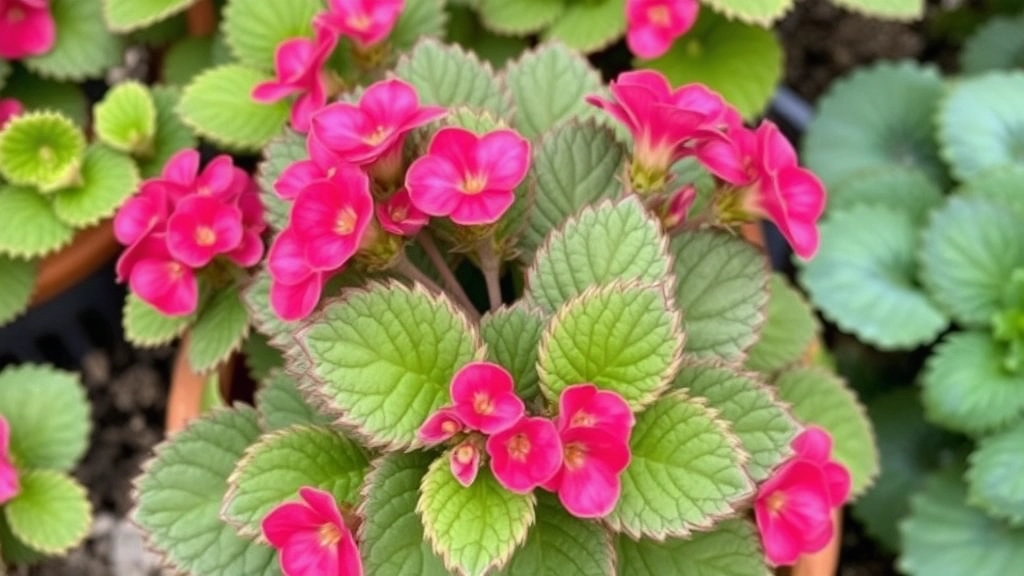Kalanchoe Temperature Tolerance
Hey there! If you’ve ever wondered about Kalanchoe temperature tolerance, you’re in the right place. These vibrant succulents are not just beautiful but also quite hardy, making them perfect for both indoor and outdoor settings. Understanding their temperature needs is crucial to keeping them healthy and thriving.
Kalanchoes can tolerate a range of temperatures, but they thrive best in conditions that mimic their natural habitat. Generally, they prefer temperatures between 60-85°F (15-29°C). However, they can endure short periods of cooler temperatures down to around 40°F (4°C). Knowing this can help you provide the best care possible, ensuring your Kalanchoes remain lush and vibrant all year round.
Ideal Temperature Range for Kalanchoe
Are you wondering what temperature your Kalanchoe needs to thrive?
Understanding the ideal temperature range is crucial for keeping your plant healthy and vibrant.
Kalanchoe plants flourish best in a temperature range of 15°C to 25°C (59°F to 77°F).
This range mimics their native environment, allowing them to thrive and produce beautiful blooms.
Key Points:
- Optimal Temperature: 15°C to 25°C (59°F to 77°F)
- Growth Phase: During the growing season, aim for the higher end of this range.
- Dormancy: In winter, Kalanchoe can tolerate slightly cooler temperatures, but not below 10°C (50°F).
Maintaining this ideal temperature is essential for promoting healthy growth and vibrant flowers.
However, what happens when temperatures dip below or rise above this range? If you notice issues like your Kalanchoe not flowering, it might be due to temperature stress. Similarly, taking care of your plant during different seasons is crucial, and you can find more tips in this fall Kalanchoe care guide.
Minimum Temperature Tolerance

Have you ever wondered how low the temperature can drop before your Kalanchoe starts to feel the chill?
Kalanchoe plants are pretty resilient, but they do have their limits when it comes to cold.
Minimum Tolerance
- Ideal Range: Kalanchoe thrives best between 15°C to 25°C (59°F to 77°F).
- Absolute Minimum: They can tolerate temperatures as low as 5°C (41°F) for short periods.
- Frost Sensitivity: Anything below 0°C (32°F) can be disastrous.
If you live in a cooler climate, it’s essential to keep an eye on those nighttime temperatures, especially during winter.
Protecting Your Plant
To keep your Kalanchoe safe from the cold, consider these tips:
- Bring Indoors: If temperatures are forecasted to drop below 5°C, it’s time to bring your plant inside.
- Use a Frost Cloth: If you can’t bring them in, a light frost cloth can provide some protection.
- Avoid Drafts: Make sure your plant isn’t near windows or doors that might let in cold drafts.
When it comes to caring for Kalanchoe, understanding its maximum temperature tolerance is essential.
As a succulent, Kalanchoe thrives in warm conditions but can suffer if temperatures soar too high.
Kalanchoe generally prefers temperatures between 20°C to 25°C (68°F to 77°F). However, it can tolerate higher temperatures up to 35°C (95°F) for short periods.
Key considerations for high temperatures:
– **Humidity Levels:** Low humidity can exacerbate the effects of heat.
– **Direct Sunlight:** While Kalanchoe enjoys bright light, too much direct sun can scorch its leaves.
– **Air Circulation:** Good airflow is crucial to prevent overheating.
If temperatures exceed these limits, your Kalanchoe may exhibit signs of stress.
Signs of heat stress include:
– Leaf wilting
– Leaf drop
– Discoloration or browning of leaf edges
To manage high temperatures effectively, consider these best practices:
– **Provide Shade:** Use sheer curtains or place the plant in a location with filtered sunlight during peak hours.
– **Water Wisely:** Ensure the soil is well-draining and water thoroughly, but avoid letting the plant sit in water.
– **Monitor Environment:** Keep an eye on temperature fluctuations, especially if your Kalanchoe is indoors. For more detailed tips on optimal sunlight for thriving Kalanchoe plants, check out our guide on [optimal sunlight for thriving Kalanchoe plants](https://planthq.org/optimal-sunlight-for-thriving-kalanchoe-plants/).
Additionally, if you notice your Kalanchoe showing signs of leggy growth due to high temperatures or insufficient light, you can find expert tips and solutions in our article on [how to fix a leggy Kalanchoe](https://planthq.org/how-to-fix-a-leggy-kalanchoe-expert-tips-solutions/).
Effects of Cold Weather on Kalanchoe

When the temperature drops, many plant enthusiasts worry about the impact on their beloved Kalanchoe. What happens when these resilient succulents face chilly conditions?
Kalanchoe, being a succulent, has specific temperature requirements that need to be met for optimal growth. Cold weather can lead to several adverse effects, which are crucial for any plant owner to understand.
Key Effects of Cold Weather:
- Leaf Damage: Exposure to cold temperatures can cause the leaves to become mushy or develop dark spots. This is a clear sign that your Kalanchoe is struggling.
- Stunted Growth: If the temperature consistently falls below the ideal range, you may notice a significant slowdown in growth. Kalanchoe thrives in warmth, and cold can hinder its development.
- Increased Vulnerability to Pests: Cold stress can weaken the plant, making it more susceptible to pests and diseases. This is particularly concerning as weakened plants may not recover as easily.
- Root Rot: If Kalanchoe is kept in cold, damp conditions, the roots can rot. This is especially true if the potting mix retains too much moisture.
To mitigate these effects, it’s essential to monitor the temperature and take proactive steps to protect your Kalanchoe during colder months.
Effects of Heat on Kalanchoe
As we explore the impact of temperature on Kalanchoe, it’s essential to consider how heat specifically affects these resilient plants.
Understanding Heat Stress
Kalanchoe thrives in warm environments, but excessive heat can lead to stress, affecting its overall health.
Key signs of heat stress include:
- Wilting Leaves: Leaves may droop or curl, indicating dehydration.
- Leaf Scorching: Edges can turn brown or crispy, signalling damage from intense sunlight.
- Stunted Growth: Growth may slow down, and flowering can be reduced.
Optimal Temperature Range
Kalanchoe prefers temperatures between 20°C to 25°C (68°F to 77°F). However, when temperatures rise above 30°C (86°F), the plant may struggle.
Strategies for Managing Heat
To keep your Kalanchoe thriving during warmer months, consider the following tips:
- Provide Partial Shade: Use sheer curtains or place your plant in a spot that receives filtered sunlight.
- Maintain Humidity: Mist the leaves or use a humidity tray to create a more favourable environment.
- Water Wisely: Water more frequently during hot spells, ensuring the soil remains moist but not soggy.
Real-Life Example
I once had a Kalanchoe that seemed to suffer every summer. After adjusting its position to a shadier spot, it flourished, showcasing vibrant blooms and healthy foliage.
Indoor vs. Outdoor Temperature Considerations

Have you ever wondered how the temperature difference between indoors and outdoors affects your Kalanchoe?
It’s a common concern for plant lovers, especially when the seasons change.
Indoor Temperature Considerations:
- Stable Environment: Indoors, your Kalanchoe enjoys a more stable temperature. Ideally, keep it between 15°C to 25°C.
- Avoid Drafts: Make sure to place it away from chilly drafts or heating vents. Sudden temperature changes can stress your plant.
- Humidity Levels: Indoor air can be dry, especially in winter. A little humidity can help, so consider misting your plant occasionally.
Outdoor Temperature Considerations:
- Natural Fluctuations: Outdoors, temperatures can swing dramatically. Kalanchoe can handle some fluctuations, but prolonged extremes can be an issue.
- Sun Exposure: Direct sunlight can heat up the leaves, especially during the summer. Aim for a spot with partial shade during peak sun hours.
- Wind Protection: Wind can lower the perceived temperature, so consider placing your Kalanchoe in a sheltered spot.
Key Takeaways:
- Indoors = stable, controlled environment.
- Outdoors = variable, needs protection from extremes.
As the seasons change, so do the temperature requirements for your Kalanchoe.
### What should you keep in mind?
#### Spring and Summer:
– **Ideal temperature:** 20°C to 25°C (68°F to 77°F).
– Ensure they receive ample sunlight but avoid direct scorching rays during the hottest part of the day.
– Regular watering is essential, but allow the soil to dry out between waterings to prevent root rot.
#### Autumn:
– Gradually reduce the temperature to around 15°C to 20°C (59°F to 68°F).
– This is a crucial time for acclimatisation, preparing your Kalanchoe for the cooler months ahead.
– Monitor watering; reduce frequency as growth slows down.
#### Winter:
– Maintain a minimum temperature of 10°C (50°F) to avoid cold stress.
– Keep the plant in a well-lit area, as light availability decreases during winter.
– Water sparingly, allowing the soil to dry out thoroughly before the next watering.
### Why is this important?
Adjusting the temperature according to the season helps your Kalanchoe thrive and prevents stress.
### Signs to Watch For:
– Leaves turning yellow or dropping can indicate temperature issues.
– Stunted growth may signal that your plant is not comfortable with its current environment.
For more detailed care tips, you might find our [care guide for flowering Kalanchoe](https://planthq.org/care-guide-for-flowering-kalanchoe-2030cm-tall-blossfeldiana/) useful. Additionally, if you’re dealing with specific issues like leaves turning red, check out our article on [why Kalanchoe leaves turn red](https://planthq.org/why-are-my-kalanchoe-leaves-turning-red-causes-solutions/).
Protecting Kalanchoe from Frost

So, you’ve got your Kalanchoe all set up, and then bam! A sudden frost hits. What do you do?
Frost can be a real nightmare for these lovely plants, and knowing how to protect them is key to keeping them thriving.
Simple Steps to Shield Your Kalanchoe
- Bring Them Indoors: If temperatures are set to drop, the easiest fix is to move your Kalanchoe inside. A sunny windowsill is perfect.
- Cover Up: If you can’t bring them in, use frost cloths or old bedsheets to cover your plants. Just make sure it’s not too tight; they need some air.
- Mulch Matters: Add a layer of mulch around the base if your Kalanchoe is in the garden. This helps insulate the roots from the cold.
- Water Wisely: Watering before a frost can actually help. Moist soil retains heat better than dry soil, providing some extra warmth.
- Choose the Right Spot: If you’re planting outdoors, pick a spot that’s sheltered from harsh winds, like against a wall or fence.
I remember one year, I forgot to bring mine in, and they got hit hard. It was a tough lesson learned!
Protecting your Kalanchoe from frost is all about being proactive and prepared.
Signs of Temperature Stress in Kalanchoe
Recognising the signs of temperature stress in Kalanchoe is essential for maintaining its health and vitality. As we delve into this topic, it’s crucial to understand how temperature fluctuations can impact your plant.
Common Signs of Temperature Stress
- Leaf Discoloration
- Yellowing leaves can indicate too much heat or cold.
- Dark spots may appear if the plant is exposed to cold drafts.
- Wilting
- Leaves may droop or become limp due to extreme heat.
- Conversely, overwatering in cold conditions can also lead to wilting.
- Leaf Drop
- If your Kalanchoe starts shedding leaves, it could be struggling with temperature extremes.
- Stunted Growth
- Slow or halted growth can signal that the plant is not in its ideal temperature zone.
- Flowering Issues
- Poor flowering or premature blooming may occur if temperatures are not suitable.
Observing Changes
It’s vital to observe your Kalanchoe regularly. If you notice any of these signs, consider the current temperature conditions. Adjusting its environment might be necessary to restore its health. For more detailed guidance, you can refer to this comprehensive Kalanchoe Flaming Katy care guide. Additionally, if you are experiencing issues with leaf discoloration, this resource on why Kalanchoe leaves turn brown might be helpful.
Best Practices for Temperature Management

So, you’ve got your Kalanchoe, and you want it to thrive, right?
Temperature management is key to keeping your plant vibrant and healthy.
1. Know Your Ideal Range
Kalanchoe loves a cozy spot between 15°C to 25°C.
Keep it within this range as much as possible.
2. Avoid Sudden Changes
Plants can be a bit dramatic when it comes to temperature shifts.
Try to keep the environment stable.
3. Use Thermometers
Invest in a simple indoor thermometer.
It’s an easy way to monitor conditions and adjust as needed.
4. Draft Protection
If your Kalanchoe is near windows or doors, watch out for drafts.
A small change in temperature can stress your plant.
5. Adjust Watering
In cooler temperatures, your Kalanchoe needs less water.
Overwatering in cold conditions can lead to root rot.
6. Consider Humidity
Kalanchoe prefers moderate humidity.
If your home is dry, especially in winter, consider a humidity tray.
7. Seasonal Moves
As the seasons change, be ready to move your plant.
In summer, it might enjoy a spot outside, but bring it in during colder months.
8. Watch for Signs
Keep an eye out for yellowing leaves or wilting.
These can be signs your plant is feeling the temperature stress.
Temperature-Related Growth Tips
Have you ever noticed your Kalanchoe struggling to thrive despite your best efforts? Temperature plays a crucial role in its growth. Here are some practical tips to ensure your Kalanchoe flourishes in the right temperature range.
- Monitor Indoor Temperatures:
- Keep indoor temperatures between 18°C to 24°C.
- Use a thermometer to check the temperature regularly.
- Adjust Outdoor Placement:
- If your Kalanchoe is outdoors, consider moving it to a shaded area during peak summer heat.
- In winter, bring it indoors if temperatures drop below 10°C.
- Use Thermoregulating Materials:
- Consider using thermal blankets or cloches for outdoor plants during cold snaps.
- These materials help maintain a stable temperature.
- Gradual Acclimatisation:
- When moving your Kalanchoe from indoors to outdoors, do it gradually to prevent temperature shock.
- Start with a few hours a day, then increase exposure over a week.
- Humidity Control:
- Maintain moderate humidity levels; too much humidity can lead to rot, while too little can stress the plant.
- A simple humidity meter can help you keep track.
- Seasonal Adjustments:
- As seasons change, adjust your watering and feeding schedule to align with temperature fluctuations.
- For instance, during warmer months, increase watering frequency slightly.
For more detailed information on caring for your Kalanchoe, check out our complete guide to Kalanchoe plant care and learn about the different Kalanchoe species you can add to your garden.
Common Temperature-Related Issues and Solutions for Kalanchoe
So, you’ve got your Kalanchoe, and everything seems peachy. But what happens when the temperature throws a tantrum?
Here are some common temperature-related issues you might face:
- Leaf Drop
If your Kalanchoe starts shedding leaves, it could be due to sudden temperature changes.
Solution: Keep it in a stable environment. Avoid placing it near drafts or heat sources. - Wilting Leaves
Wilting can signal that your plant is too hot or too cold.
Solution: Check the temperature. Aim for that sweet spot of 15-25°C (59-77°F) and adjust accordingly. - Discoloration
Yellowing leaves often indicate stress from either too much heat or cold.
Solution: Monitor the conditions. If it’s too hot, consider moving it to a cooler spot. - Stunted Growth
If your Kalanchoe isn’t growing as it should, temperature might be the culprit.
Solution: Ensure it’s within the ideal range. A little warmth can work wonders! - Fungal Issues
Cold, damp conditions can lead to fungal infections.
Solution: Ensure good airflow and avoid overwatering, especially in cooler months.
Quick Tips for Temperature Management:
- Use Thermometers: Keep an eye on the temperature with a simple indoor thermometer.
- Adjust Watering: Water less in cooler temperatures, as plants use less moisture.
- Create Microclimates: Use curtains or screens to shield your plant from extreme temps.
Remember, keeping your Kalanchoe happy is all about balance. For more detailed care tips, you can check out our care tips for thriving in Texas climate or learn about the key features of different Kalanchoe species.
FAQs on Kalanchoe Temperature Tolerance
What is the ideal temperature range for Kalanchoe?
Kalanchoe thrives best between 15°C to 25°C (59°F to 77°F).
What is the minimum temperature Kalanchoe can tolerate?
Kalanchoe can tolerate temperatures as low as 5°C (41°F) for short periods.
Can Kalanchoe survive frost?
No, temperatures below 0°C (32°F) can be disastrous for Kalanchoe.
How can I protect my Kalanchoe from cold weather?
To protect your Kalanchoe from the cold, you can:
- Bring it indoors if temperatures drop below 5°C.
- Use a frost cloth for additional protection.
- Avoid placing it near windows or doors that let in cold drafts.
What are the effects of cold weather on Kalanchoe?
Cold weather can cause:
- Leaf damage, such as mushy leaves or dark spots.
- Stunted growth if temperatures consistently fall below the ideal range.
- Increased vulnerability to pests and diseases due to cold stress.
- Root rot in cold, damp conditions.
What should I consider for indoor Kalanchoe care?
Indoors, maintain a stable temperature between 15°C to 25°C, avoid drafts, and ensure moderate humidity. Misting occasionally can help.
What should I consider for outdoor Kalanchoe care?
Outdoors, be mindful of natural temperature fluctuations, provide partial shade, and protect from wind. Mulching can help insulate the roots.
How can I protect my Kalanchoe from frost?
To shield your Kalanchoe from frost:
- Bring it indoors to a sunny windowsill.
- Cover it with frost cloths or old bedsheets.
- Add a layer of mulch around the base if planted in the garden.
- Water wisely before a frost, as moist soil retains heat better.
- Choose a sheltered spot for outdoor planting.
What are the best practices for temperature management for Kalanchoe?
Best practices include:
- Maintaining an ideal temperature range of 15°C to 25°C.
- Avoiding sudden temperature changes.
- Using indoor thermometers to monitor conditions.
- Protecting from drafts near windows or doors.
- Adjusting watering frequency in cooler temperatures.
- Maintaining moderate humidity levels.
- Moving the plant indoors or outdoors as seasons change.
- Watching for signs of temperature stress like yellowing leaves or wilting.
References
-
Kalanchoe Cold Tolerance: How Cold Can Kalanchoe Plants Get?
-
The Spruce: Kalanchoe Plant Care Guide
-
Better Homes & Gardens: Kalanchoe Care Guide
